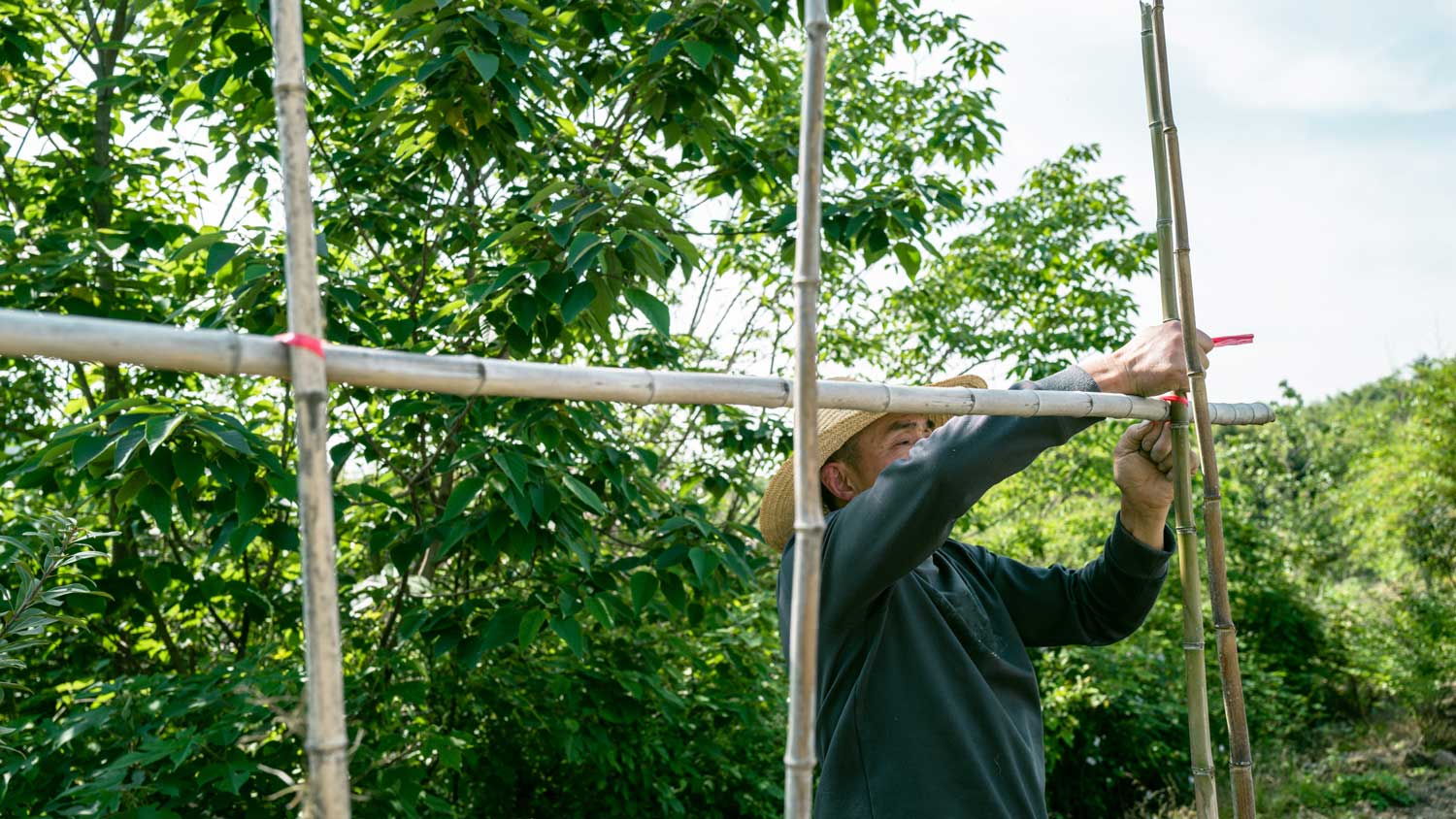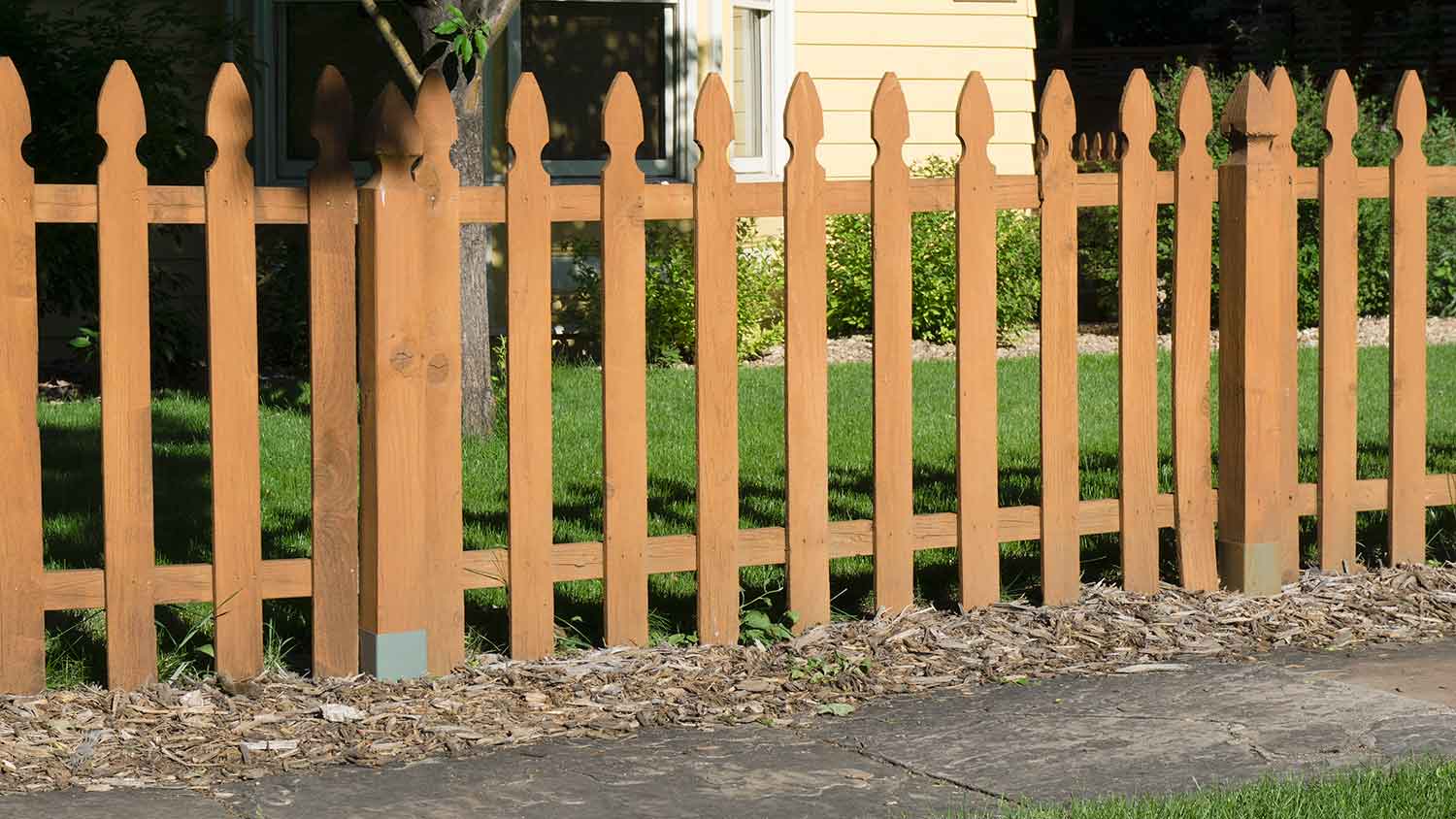How to Build a Bamboo Fence
Building a bamboo fence provides charm and privacy—but it's tough work


- Auger or post hole digger
- Shovel
- Tamper
- Hammer
- Measuring tape
- Gravel
- Concrete (optional)
- Nails
- Screws
- Bamboo
A bamboo fence adds a lot of personality to your outdoor space. You can build a traditional bamboo fence using twine or a modern one designed to stand up to the elements for years. Bamboo fences make good privacy fences, but you can also space out pickets for a more decorative look. And if you’ve got the tools, some patience, and fencing know-how, they’re a great weekend DIY project.
If you’re ready for the challenge, we’ll walk you through how to build a bamboo fence below.
Building a fence requires specific equipment to ensure it is level, deep enough into the ground and properly fastened together. While you may be able to rent it from your local hardware store, we suggest contacting a pro with the proper tools and experience for the job.
How to Build a Bamboo Fence

Building a bamboo fence is tough and time-consuming work, but if you’re up for the task, here’s how to get it done:
1. Decide on the Design and Materials
A little preparation goes a long way when constructing a bamboo fence. Before you start the work—or even buy supplies—do some research to determine what kind of bamboo fence you’ll build.
Decide between all bamboo or a bamboo and wood combination: If you build a traditional fence made entirely of bamboo (pickets, posts, and stringers), you’ll use twine to tie the pieces together. However, the twine will deteriorate over time, meaning you’ve got to stay on top of bamboo fence maintenance. Alternatively, you can use bamboo for the pickets but use wood or metal for your posts and stringers. Cedar and oak are among the best woods for fence posts and stringers.
Decide between pickets or panels: A true DIY bamboo fence shouldn’t look perfect. You’ll get bamboo pieces of different circumferences and color variations and mix and match them together to form pickets. If you want a more uniform look, however, you can purchase prefabricated bamboo panels to attach to your wood or metal posts and stringers; this also makes for a faster install.
Decide between decorative and privacy: A decorative bamboo fence will have pickets every six to 12 inches or may even have a criss-cross design pattern with the pickets. A privacy fence requires significantly more bamboo shoots, fit snugly together, so you can’t really see through the fence. This will impact how much bamboo you need to purchase.
As we continue to discuss how to build a fence, we’ll focus on a bamboo privacy fence with custom pickets and wood posts and stringers.
2. Complete Site and Material Preparations
Now that you know how you’ll construct your bamboo fence, you’ve got to do a little prep work:
Get a permit and check that it’s safe to dig: In most municipalities, you must obtain a permit to construct a fence on your property. If you’ll be digging post holes, you should also call 811 to determine where gas and utility lines run underground. Do this before planning the layout of the fence in case it affects the path you envisioned your fence following.
Plan the layout of your fence: You’ll need to determine the perimeter of the proposed fence to estimate how much of each material you’ll need.
Buy your supplies: Once you’ve calculated how much wood and bamboo you’ll need, head to the store or order online. Always purchase roughly 30% more to allow for waste and mistakes.
3. Install the Posts
Once you’ve planned the layout of the fence, you’ll need to dig holes and install the posts. Alternatively, if you’re installing the fence over concrete, you’ll need to fasten the posts with concrete fixing bolts or a steel wedge.
For a deeper dive into this step, review our guide on how to install fence posts.
4. Build Out a Panel Frame
Screw in joist holders to the sides of each fence post, then cut and lay in the wood stringers (a top and bottom row). Then screw two wood fence pickets to the backs of the stringers, one near each end, to fasten them together. This forms the frame for your panel of bamboo pickets.
Remove the frame from the joist holders and transport it to your sawhorses, laying it flat. It will be easier to lay out and install your bamboo pickets on this surface instead of a frame affixed to the posts.
5. Lay Out and Screw In Pickets Between Frame Ends
Grab a bunch of bamboo shoots and lay them out between the two ends of the stringers. Leave enough room on the ends of each stringer for them to be inserted back into the joist holders. Bamboo shoots aren’t perfectly sized; you’ll have to arrange them to form a layout that looks good and leaves the fewest gaps, if you’re going for a privacy fence.
Once you’ve arranged the bamboo fence pickets on the frame, screw them in at the top and bottom, one by one.
6. Cut Off Excess Bamboo
Your bamboo shoots are likely different lengths. Use a level and a straight wooden fence picket to draw a straight line above the top stringer and below the bottom stringer, marking where you’ll want to cut off excess bamboo to ensure an even fence. Remember, your bamboo shoots can’t be too long at the bottom, as they have to sit just above ground level.
Once you’ve got your line, make your cuts using a circular saw.
7. Attach Panel and Repeat
Once you’re satisfied with the bamboo fence panel you’ve just built, carry it back to the set of fence posts it will sit between and slide the stringers into place in the joist holders. Screw these in to secure them.
Repeat steps 4 through 7 to build additional panels. Remember, you’ll also need to install at least one gate to allow entry and exit from the fenced-in area. Read up on how to install gate hinges if you’re new to gate installation; you can also hire a local gate pro if you’d like help with this step.
DIY vs. Hiring a Pro
Installing a bamboo fence can be hard work, especially if you want a traditional, rustic look rather than a prefabricated panel. If you don’t have the time, patience, strength, endurance, and skill with drills and saws, this is a job better left to a local fence installer.
You’ll pay about double the material costs for the whole install when hiring a pro; labor accounts for 50% of the cost to install a fence. Alternatively, you can simplify the DIY installation by purchasing a prefabricated bamboo fence with an easy-to-install metal frame and full bamboo panels; however, the cost of these prefab units is much higher than purchasing materials for a custom fence.
Frequently Asked Questions
How long it takes to install a fence depends on the size of the fence; the longer the fence, the longer the install will take. That said, you can typically install a bamboo fence over a weekend for a reasonably sized yard. A team of fencing contractors can likely get your bamboo fence assembled in half a day to a day.
A bamboo fence can last up to 20 years when properly installed and maintained. Bamboo is a durable material, but to get the most life out of it, you should clean and seal the fence every few years. Staining the bamboo can also restore the appearance if the color fades over time. Use screws to fasten the bamboo, rather than twine, to ensure the bamboo fence stays together longer.
Traditional bamboo fences use twine to attach pickets to posts and stringers, but you have to keep an eye on the twine, as it will deteriorate over time. Alternatively, you can fasten bamboo pickets to framing using fence screws.




















